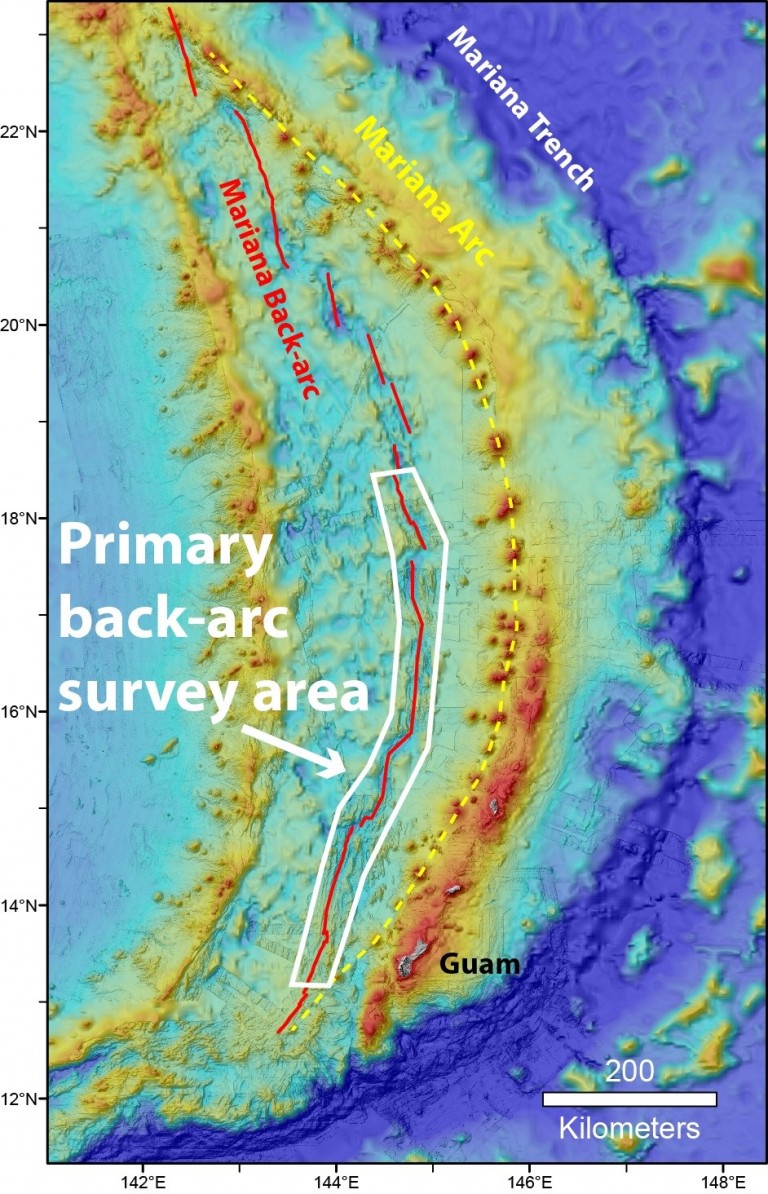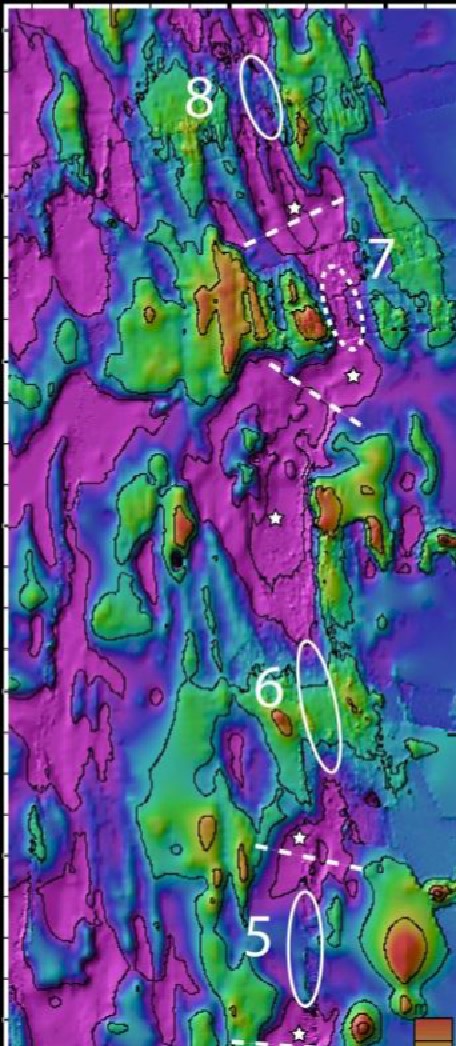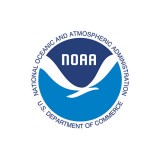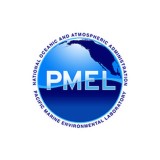The Mariana region, famed for boasting the deepest spot on the planet, is also home to the Mariana subduction system. This mash-up of tectonic plates includes a wide range of geological settings and marine habitats, including a very deep trench, a shallow volcanic arc, and a mid-depth back-arc spreading center. This great diversity of settings and habitats makes the Marianas a valuable natural laboratory for testing ideas about the distribution of animal species within hydrothermal vent ecosystems.
In the Mariana region, only the volcanic arc has been systematically explored for hydrothermal vents, resulting in the discovery of 20 hydrothermally active seamounts and over 20 new species. These remarkable discoveries directly inspired the establishment of the Marianas Trench Marine National Monument in 2009.
In contrast, more than 1000 kilometers of the Mariana back-arc remains almost completely unexplored.
Focusing on the Back-Arc
Last November, scientists aboard Falkor aimed to shed light on the Mariana Back-arc, expecting it to be teeming with activity and life. Principal Investigator Joseph Resing, of the University of Washington, led a team of researchers from the University of Washington, Oregon State University, and NOAA/PMEL, over the course of the 27 day mission at sea. Their goal was to explore the back-arc spreading center to find new sites of hydrothermal activity and to better understand the physical, chemical, and geological forces that shape biodiversity in these unique ecosystems.
Life in the Shadowy Depths
These researchers expected that the Mariana back-arc would host many sites of hydrothermal activity with chemosynthetic ecosystems. “Chemosynthesis” refers to organisms that transform carbon dioxide into organic matter in the same manner as plants, but, instead of using the energy from sunlight to do this — as in photosynthesis — they use chemical energy instead, mostly from hydrogen, methane, hydrogen sulfide, and iron. Chemosynthetic ecosystems exist in locations on the seafloor where chemical energy is present from seafloor hot springs, cold seeps, or other microbiological processes.
Shaping Earth, Shaping Life
The Mariana subduction system offers living organisms a range of conditions unlike any other region on the planet. During subduction, two of Earth’s tectonic plates collide. However, instead of crashing into each other and crumpling like a car wreck, one of the plates dives beneath the other, producing a deep trench. The down-going plate causes melting in the overlying mantle, creating magma that feeds the active volcanoes of the overlying arc. Further to the west, the back-arc is a zone of spreading in the overriding plate, where mantle magmas well up and new ocean crust is formed. For the chemosynthetic ecosystems, each of these tectonic environments create different geophysical and geochemical conditions. These differences seem to be reflected in the diversity of biological communities on the seafloor.
The Right Tools
Searching for hydrothermal vents is not an easy task due to the technical challenges of working in the deep ocean. The team used the Sentry Autonomous Underwater Vehicle (AUV), as well as instrument packages consisting of optical and chemical sensors to survey systematically for hydrothermally active areas. These sites could hold the answers to fundamental questions about the relationships between ecosystems, geologic settings, and fluid geochemistry.
Identifying vent sites
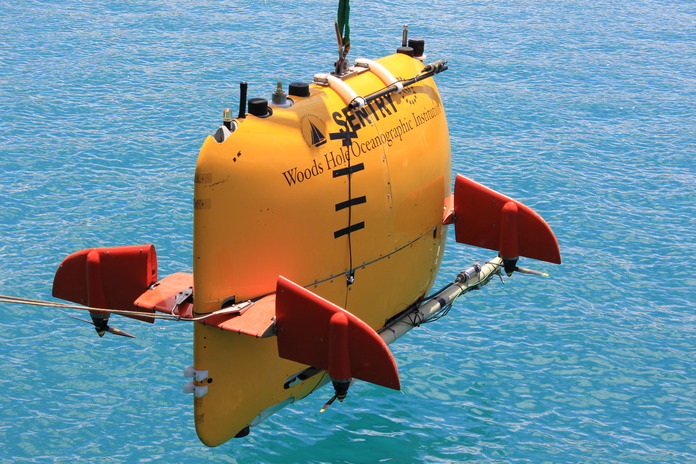
The research from this cruise helped test the idea that arc and back-arc sites have distinct ecosystems, controlled by each settings’ geology and unique fluid chemistry. In order to test this hypothesis, several tasks had to be accomplished. The science team began by finding and identifying active vent sites along the Mariana back-arc, and characterizing each site by its depth, geologic setting, temperature, chemical composition, and rise heights of hydrothermal plumes. During a follow-up expedition in 2016, the scientists will return with a remotely operated vehicle (ROV) to visually explore and sample the new vent sites on the seafloor.
The science team found some surprises given how little exploration had been done on the back-arc, including several new sites. We consider the Mariana system as a natural laboratory where hypotheses about the interrelations between tectonics, biodiversity, and biogeographic patterns can be tested. After constructing a geological and geochemical model of the back-arc vent settings, the team plans on combining the model with biodiversity data, to better define the relationships between geologic setting, chemical environment, and biological communities.
Partial support for this expedition comes from the NOAA Ocean Exploration and Research Program and the NOAA Pacific Marine Environmental Laboratory.
by Logan Mock-Bunting and Carlie Wiener
Data & Publications
The resulting shipboard dataset is being stored at the Rolling Deck to Repository.
Backscatter: Optical, Pressure, and Temperature acquired from MAPR device mounted on AUV Sentry are now available on the Marine Geoscience Data System repository.
Conductivity, Pressure, Temperature collected from AUV Sentry are now available on the Marine Geoscience Data System repository.
- Cruise Report: Hydrothermal Hunt at Mariana
- I-Poster: Exploring and Protecting the Marvelous Marianas Trench Marine National Monument
- Baker, E., Walker, S., Resing, J., Chadwick, W., Merle, S., and Anderson, M. (2016). Hydrothermal Plume Surveys of the Mariana Backarc (12.7°-18.3°N) by Surface-Ship and AUV Find an Unexpectedly High Spatial Frequency of Vent Sites, Oral Presentation, American Geophysical Union Fall Meeting, San Francisco, CA, USA.
- Resing, J., Chadwick, W., Baker, E., Butterfield, D., Baumberger, T., Buck, N., Walker, S., and Merle, S. (2016). Hydrothermal exploration of the Mariana Back Arc Basin: Chemical Characterization, Poster Presentation, American Geophysical Union Fall Meeting, San Francisco, CA, USA.
- Walker, S., Baker, E., Resing, J., Chadwick, W., Merle, S., and Kaiser, C. (2016). High Resolution Mapping of Hydrothermal Plumes in the Mariana Back-arc Relate Seafloor Sources to Above-bottom Plumes, Poster Presentation, American Geophysical Union Fall Meeting, San Francisco, CA, USA.
- Hirsh, H., Chadwick, Jr., W., Fryer, P., Villagomez, A., Beauregard, L., Cabrera, I., and Peterka, L. (2016). Exploring and Protecting the Marvelous Marianas Trench Marine National Monument, Poster Presentation, International Union for Conservation of Nature (IUCN) World Conservation Congress, Honolulu, HI, USA.
- , C, , M., , S., , J., , E., , D., , S., and (2017). Geological interpretation of volcanism and segmentation of the Mariana back-arc spreading center between 12.7°N and 18.3°N, Geochem. Geophys. Geosyst., 18, 2240–2274, doi:10.1002/2017GC006813. [This publication is available as OPEN ACCESS].
- Baker, E., Walker, S., Resing, J., Chadwick, Jr., W., Merle, S., Anderson, M., Butterfield, D., Buck, N., and S. Michael. (2017). The Effect of Arc Proximity on Hydrothermal Activity Along Spreading Centers: New Evidence from the Mariana Back-Arc (12.7° - 18.3°N). Geochem. Geophys. Geosyst.. Accepted Author Manuscript. doi:10.1002/2017GC007234. [This article has been published as OPEN ACCESS].
- Anderson, M., Chadwick, Jr., W., Merle, S., Resing, J., Baker, E., Walker, S., Hannington, M., and N. Augustin. (2017). Relationship between Tectonism, Volcanism, and Hydrothermal Venting along the Mariana Back-arc Spreading Center between 12.7N and 18.3N. Oral Presentation at AGU Chapman Conference on Submarine Volcanism, Hobart, Tasmania, AUS.
- Anderson, R., Reveillaud, J., Reddington, E., Delmont, T., Eren, A., McDermott, J., Seewald, J., and Huber, J. (2017). Genomic Variation in Microbial Populations Inhabiting the Marine Subseafloor at Deep-sea Hydrothermal Vents. Nature Communications 8, 1114 (2017), doi: 10.1038/s41467-017-01228-6. [This article is published as OPEN ACCESS].
- Chadwick, Jr., W., Merle, S., Kaiser, C., Baker, E., Walker, S., Resing, J., Butterfield, D., Baumberger, T., Anderson, M., Shore, P., Wiens, D., and Rubin, K. (2017). A Recent Volcanic Eruption Discovered on the Central Mariana Back-arc Spreading Center. Oral Presentation at IAVCEI 2017 General Assembly, Portland, OR, USA.
- Chadwick, Jr. W. From Galapagos to Mariana: Discovering the Diversity of Hydrothermal Vent Environments, Oral Presentation at OSU and Hydrothermal Vents: 40th Anniversary of the Discovery that Launched 1000 Ships, Corvallis, OR, USA.
- Chadwick, W., Tunnicliffe, V., Butterfield, D., Bates, A., Huber, J., Trembath-Reichert, E., Bobbitt, A., and Merle, S. (2018). Newly Discovered Hydrothermal Vent Sites Along the Mariana Back-arc Spreading Center Support Hypothesis of Geological and Chemical Control on Chemosynthetic Ecosystems. Poster Presentation at Ocean Sciences Meeting, Portland, OR, USA.
- Baker, E., Walker, S., Resing, J., Chadwick, W., Merle, S., Anderson, M., and D. Butterfield. (2018). Hydrothermal Activity Along Back-Arc Spreading Centers: The Importance of Arc Proximity. Poster Presentation at Ocean Sciences Meeting, Portland, OR, USA.
- Chadwick, W., Merle, S., Baker, E., Walker, S., Resing, J., Butterfield, D., Anderson, M., Baumberger, T., and A. Bobbitt (2018), A recent volcanic eruption discovered on the central Mariana back-arc spreading center, Front. Ear. Sci., 6:172, doi:10.3389/feart.2018.00172. [This paper is published as OPEN ACCESS.]
In the News
New Deep-Sea Vents and Volcanic Activity Discovered in the Mariana Back-Arc
Sevenseas Marine Conservation & Travel • January 8th, 2016
Deep-sea Vents and Volcanic Activity Discovered
Hydro International • January 4th, 2016
Deep-sea Vents and Volcanic Activity Discovered
Saipan Tribune • December 28th, 2015
New Deep-Sea Vents, Volcanic Activity Found in Mariana Back-Arc
Marine Link • December 18th, 2015
New Deep-Sea Vents, Volcanic Activity Found in Mariana Back-Arc
Marine Technology Reporter • December 18th, 2015
New Deep-Sea Vents, Volcanic Activity Found in Mariana Back-Arc
Maritime Professional • December 18th, 2015
Fledermaus, 4D visualization and analysis
QPS VBl • December 17th, 2015
Backscatter – The Mariana Trough
Physics Today Magazine • August, 2016
Researchers discover deepest known underwater volcanic eruption
The Register Guard • October 23rd, 2018
OSU-led researchers find Earth’s deepest eruption
The Register Guard • October 24th, 2018
The Deepest Volcanic Eruption Ever Documented Left a Gnarly Sight on the Ocean Floor
Gizmodo • October 25th, 2018
Geological Survey Discovers Active Volcano 14,000 Feet Under The Sea
Forbes • October 26th, 2018
A Vault of Glass and the Deepest Volcanic Eruption Ever Detected
The New York Times • October 30th, 2018
We Have Found The Deepest Known Volcanic Eruption – A Field of Glass Under The Sea
Science Alert • November 2nd, 2018
